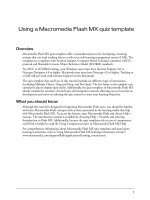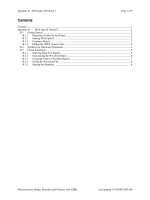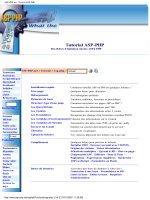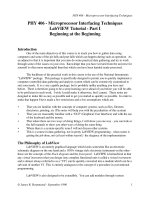Tutorial Review-3.Docx
Bạn đang xem bản rút gọn của tài liệu. Xem và tải ngay bản đầy đủ của tài liệu tại đây (130.85 KB, 42 trang )
PERFECT COMPETITIVE MARKET-EXERCISES
Perfect-> price takes, P=MC, P=MR=AR, P set by market-> maximum welfare
Monopoly->only one firm-> price makers-> deadweight loss
Monopolistic competition->many sellers->price makers->deadweight loss
Oligopoly->only 2-4 firms-> price makers->deadweight loss
1. A firm has market power if it can
a. maximize profits.
b. minimize costs.
c. influence the market price of the good it sells.
d. hire as many workers as it needs at the prevailing wage rate.
2. For any competitive market, the supply curve is closely related to the
a. preferences of consumers who purchase products in that market.
b. income tax rates of consumers in that market.
c. firms’ costs of production in that market.
d. interest rates on government bonds.
3. Who is a price taker in a competitive market?
a. buyers only
b. sellers only
c. both buyers and sellers
d. neither buyers nor sellers
4. When a firm has little ability to influence market prices it is said to be in a
a. competitive market.
b. strategic market.
c. thin market.
d. power market.
5. Free entry means that
a. the government pays any entry costs for individual firms.
b. no legal barriers prevent a firm from entering an industry.
c. a firm's marginal cost is zero.
d. a firm has no fixed costs in the short run.
6. Why does a firm in a competitive industry charge the market price?
a. If a firm charge less than the market price, it loses potential revenue.
b. If a firm charge more than the market price, it loses all its customers to other firms.
c. The firm can sell as many units of output as it wants to at the market price.
d. All of the above are correct.
7. Firms that operate in perfectly competitive markets try to
a. maximize revenues.
b. maximize profits.
c. equate marginal revenue with average total cost.
d. Both b and c are correct.
Table 13-1
Quantity Total Revenue
0
1
2
3
4
$0
$7
$14
$21
$28
Average
Revenue
Marginal
Revenue
7
7
7
7
7
7
7
7
8. Refer to Table 13-1. For a firm operating in a competitive market, the price is
a. $0.
b. $7.
c. $14.
d. $21.
9. Refer to Table 13-1. For a firm operating in a competitive market, the marginal
revenue is
a. $0.
b. $7.
c. $14.
d. $21.
10. Refer to Table 13-1. For a firm operating in a competitive market, the average
revenue is
a. $21.
b. $14.
c. $7.
d. $0.
11. Suppose that a firm operating in perfectly competitive market sells 200 units of output
at a price of $3 each. Which of the following statements is correct? P=MR=AR
i) Marginal revenue equals $3.
ii) Average revenue equals $600.
iii Average revenue exceeds marginal revenue, but we don’t know by how much.
)
a.
b.
c.
d.
i) only
iii) only
i) and ii) only
i), ii), and iii)
12. Suppose a firm in a competitive market received $1,000 in total revenue and had a
marginal revenue of $10 for the last unit produced and sold. What is the average
revenue per unit, and how many units were sold? P=MR=AR
a. $5 and 50 units
b. $5 and 100 units
c. $10 and 50 units
d. $10 and 100 units
Table 13-3
The following table presents cost and revenue information for Soper’s Port Vineyard.
Quantity
Produced
0
1
2
3
4
5
6
7
8
COSTS
Total
Cost
$100
$150
$202
$257
$317
$385
$465
$562
$682
Marginal Quantity
Cost
Demanded
-0
1
2
3
4
5
6
7
8
REVENUES
Total
Price
Revenue
$120
$120
120
$120
240
$120
360
$120
480
$120
600
$120
720
$120
840
$120
960
Marginal
Revenue
-120
120
120
120
120
120
120
120
13. Refer to Table 13-3. What is the total revenue from selling 7 units?
a. $120
b. $490
c. $562
d. $840
14. Refer to Table 13-3. What is the total revenue from selling 4 units?
a. $120
b. $257
c. $317
d. $480
15. Refer to Table 13-3. What is the marginal revenue from selling the 3rd unit?
a. $55
b. $120
c. $137
d. $140
16. Refer to Table 13-3. What is the average revenue when 4 units are sold?
a. $60
b. $120
c. $125
d. $197
17. The intersection of a firm's marginal revenue and marginal cost curves determines the
level of output at which
a. total revenue is equal to variable cost.
b. total revenue is equal to fixed cost.
c. total revenue is equal to total cost.
d. profit is maximized.









